Fifth Grade Online Math Curriculum
Math is a very crucial component of a fifth grade education. Whether you homeschool or not, helping your child achieve the necessary fifth grade math objectives allows them to be prepared, confident and knowledgeable as they head into middle school and beyond. Without a solid understanding of the basics, learning more advanced math in the future will prove increasingly difficult.
What Math Should a Fifth Grader Know?
In fifth grade math students predict the relative size of solutions in addition, subtraction, multiplication, and division of whole numbers, addition, subtraction, and multiplication of fractions, decimals, and mixed numbers. Additionally, they should have achieved mastery in numeration, rounding, money, and the customary and metric system, just to name a few.
Below are some concepts a fifth grader should know.
- Rounding numbers to the nearest ten, hundred, thousand, ten thousand and hundred thousand
- Using partial products and mental multiplication
- Dividing with two-digit divisors
- Ordering and comparing fractions
- Comparing perimeter and area
Check out Time4Learning’s fifth grade math lesson plans below to learn about the concepts your child will learn when using our curriculum.
Fifth Grade Math Objectives
Below are just some of the fifth grade math objectives your child is expected to achieve. Finding a comprehensive and effective fifth grade math curriculum will ensure your child is learning all the important concepts and topics necessary to move on to sixth grade.
- Use place value to add, subtract, multiply and divide decimals
- Apply formulas to solve various customary length/weight/capacity/temperature problems
- Calculate the probability of an event
Additionally, Time4MathFacts helps with math fact fluency through interactive and gamified video lessons that help students practice and master important math facts in addition, subtraction, multiplication, and division.
Time4Learning’s Fifth Grade Math Lesson Plans
Students will use Roman and Greek numerals.
Students will use numeric digits and words to read and write numbers up to the hundred billions.
Students will show numbers in standard and expanded form up to the billions place.
Students will compare and order numbers using place value chart and number lines.
Students will round numbers up to one billion and use concept of rounding to solve real-world problems.
Students will use estimation strategies to solve real-world problems in which they will find the sum and the difference.
Students will estimate and evaluate items for reasonableness and determine the reasonableness of given answers.
Students will add and subtract whole numbers.
Students will multiply whole numbers.
Students will solve multiplication problems that involve two-digit by two-digit multiplication as well as three-digit by two-digit multiplication.
Students will solve real-world problem involving estimation with two-by-two digit multiplication as well as three-digit by two-digit multiplication.
Students will determine the greatest common factor of given numbers.
Determine the least common multiple of given numbers.
Students will use exponents to solve problem.
Students will identify powers of 10 through the 6th power.
Students will use patterns when multiplying by powers of ten.
Students will explore exponents as repeated multiplication.
Students will divide to solve problems.
Students will use compatible numbers to estimate quotients.
Students will apply the divisibility rules of 2, 3, 5, 9, and 10 to various numbers.
Students will interpret remainders and apply the concepts in order to identify what remainders signify.
Students will use order of operations to solve problems.
Students will define and identify prime and composite numbers up to 50. Students will find the prime factorization of numbers up to 50.
Students will write factors of numbers using prime numbers only and prime factorization.
Students will solve real-life problems.
Students will understand that a digit in one place represents 10 times as much as it represents in the place to its right and one-tenth of what it represents in the place to its left.
Students will read and write numbers to the thousandths in written and standard form and show equivalencies between the two.
Students will identify the number and place on the number line to signify given decimals.
Students will use <, > and = to compare decimals through thousandths. Students will order decimals through thousands.
Students will round decimals to an identified place value and to the nearest half or whole number.
Students will add and subtract decimals.
Students will estimate sums and differences with decimals.
Students will multiply decimals by other decimals.
Students will divide decimals with decimals and whole number in both the divisor and dividend.
Students will estimate products and quotients using decimals.
Students will identify percents.
Students will find the percent of a number and solve real-world problems using percents.
Students will identify improper and mixed numbers and demonstrate their ability to find the equivalencies between the two.
Students will determine the least common denominator of fractions with unlike denominators.
Students will simplify fractions by find the lowest common denominator.
Students will find equivalent forms of fractions not including mixed numbers.
Students will compare and order fractions.
Students will round fractions to the nearest half or whole number.
Students will add fractions, not including mixed numbers, with like and unlike denominators.
Students will subtract fractions, not including mixed numbers, with like and unlike denominators.
Students will solve real-world problems involving subtracting fractions with unlike denominators.
Students will add mixed numbers with and without regrouping.
Students will subtract mixed numbers with and without regrouping.
Students will represent the product of two fractions using an area model.
Students will determine the effect of multiplying a whole number by a fraction less than 1 and by a fraction greater than 1.
Students will multiply fractions, not including mixed numbers, and simplify answers.
Students will solve problems involving multiplying a fraction by a mixed number, and multiplying a mixed number by a mixed number.
Students will model dividing whole numbers by unit fractions and unit fractions by whole numbers.
Students will solve real-world problems involving dividing with unit fractions.
Students will divide fractions, not including mixed numbers, by using reciprocals and simplify answers.
Students will estimate products and quotients using fractions.
Students will interpret a fraction as representing division.
Students will write fractions as decimals.
Students will demonstrate their understanding of the relationship between decimals and fractions and fractions to decimals and how they are equivalent to percents.
Students will learn fractions as ratios.
Students will find equivalent ratios.
Students will recognize the percent sign and understand percent as per hundred. Students will express equivalences between fractions, decimals and percentages and know common equivalencies.
Students will describe life situations using integers and identify integers on a number line.
Students will determine patterns in pictures and tables and describe the function rule.
Students will write and evaluate algebraic expressions.
Students will find the rule in real-world problems and identify function rules from tables.
Students will solve one-step equations with whole numbers, decimals and fractions involving addition.
Students will solve one-step equations with whole numbers, decimals, and fractions involving subtraction.
Students will solve one-step equations with whole numbers and decimals involving multiplication.
Students will solve one-step equations with whole numbers and decimals involving division.
Students will apply formulas to solve customary length problems. Students will identify the correct tools to use to solve customary length problems and apply concepts of estimation to arrive at answers.
Students will apply formulas to solve customary weight problems. Students will identify the correct tools to use to solve customary weight problems and apply concepts of estimation to arrive at answers.
Students will apply formulas to solve customary capacity problems. Students will identify the correct tools to use to solve customary capacity problems and apply concepts of estimation to arrive at answers.
Students will apply formulas involving temperatures in Fahrenheit degrees to solve real-life problems.
Students will learn about the metric system and learn how multiplying and dividing by ten affects the placement in the system.
Students will apply formulas to solve metric length problems. Students will identify the correct tools to use to solve metric length problems and apply concepts of estimation to arrive at answers.
Students will apply formulas to solve metric weight problems. Students will identify the correct tools to use to solve metric weight problems and apply concepts of estimation to arrive at answers.
Students will apply formulas to solve metric capacity problems. Students will identify the correct tools to use to solve metric capacity problems and apply concepts of estimation to arrive at answers.
Students will apply formulas involving temperatures in Celsius degrees to solve real-life problems.
Students will solve problems about elapsed time.
Students will solve problems showing elapsed time involving days, weeks, months, years and centuries.
Students will find perimeter of polygons and regular polygons with and without missing values.
Students will find the area of squares and rectangles.
Students will find the area of triangles.
Students will find the volume of cubes and rectangular prisms.
Students will find the volume of a rectangular prism by counting unit cubes.
Students will find the volume of a rectangular prism by multiplying the edge lengths, or by multiplying the area of the base by the height.
Students will find the volume of a rectangular prism by applying the formula V = B × h.
Students will find the volume of a solid figure composed of two rectangular prisms.
Students will use coincident, collinear, parallel and perpendicular to describe relative orientation on a coordinate grid.
Students will identify parallel, perpendicular, intersecting and skew lines.
Students will measure the degrees in right, acute, obtuse and straight angles using a protractor.
Students will identify different kinds of triangles.
Students will sort polygons by attributes. Students will classify quadrilaterals as parallelograms, trapezoids, rhombi, rectangles and squares.
Students will classify quadrilaterals as parallelograms, trapezoids, rhombi, rectangles and squares.
Students will learn about three-dimensional figures.
Students will sort polyhedrons by their attributes.
Students will identify the arc, chord, radius and diameters of circles. Students will calculate the radius or diameter of a circle.
Students will build 3-dimensional shapes from a set of views.
Students will identify and create a 2-dimensional representation of a 3-dimensional figure (nets) on a grid or dot paper.
Students will find measurement of angles.
Students will learn about ordered pairs.
Students will classify plane figures as having line symmetry, point symmetry, both or none.
Students will apply multiple transformations to a plane figure, predict the result and identify the image of a plane figure as the result of a multiple transformation including 90 degree and 180 degree rotations.
Students will use a scale to show relative size on a map or drawing.
Students will explore similarity using congruent angles. Students will explore congruence using congruent segments and congruent angles.
Students will determine and represent all possible outcomes for a particular probability event using charts, lists or tree diagrams.
Students will calculate the probability of an event.
Students will make predictions for future events based on previous occurrences.
Students will interpret and analyze bar graphs.
Students will interpret line graphs (interpolation and extrapolation).
Students will create and interpret circle graphs using common fractions.
Students will interpret, analyze and create histograms.
Students will interpret and analyze Venn Diagrams.
Students will choose the most appropriate graph for a set of data and make inferences from the graphs.
Students will compare and translate data from information, tallies and data to a graph.
Students will collect, organize and describe data using median, mode and range.
Students will find the mean of a given set of numbers.
Students will use knowledge of stem-and-leaf plots to solve to identify mean, median, mode and range.
Why Choose Time4Learning 5th Grade Math Curriculum
The Time4Learning fifth grade math curriculum is a comprehensive online program that teaches important math concepts using an interactive, multimedia-based approach. Students are taught the material and have plenty of opportunities to practice along the way. Scored activities as well as quizzes help gauge understanding, while automated grading and recordkeeping allow parents to keep track of how their children are progressing.
The Time4Learning 5th grade math curriculum can be used as the core curriculum in your homeschool or as a supplement for fifth grade math practice. Many parents also use Time4Learning as a summer learning tool to prevent the dreaded summer brain drain.







